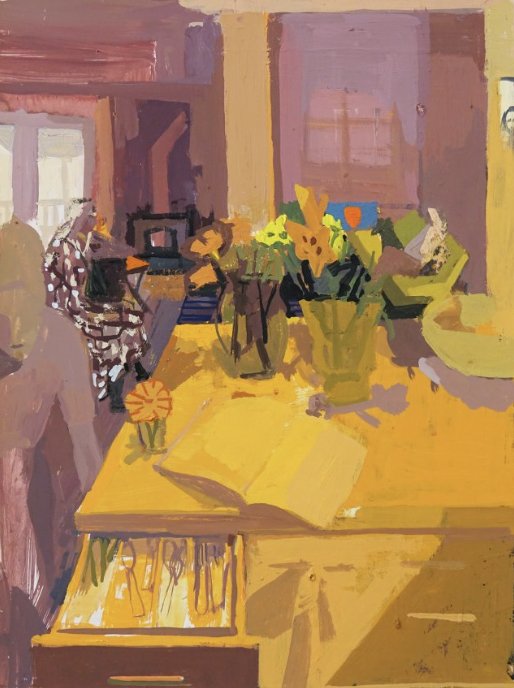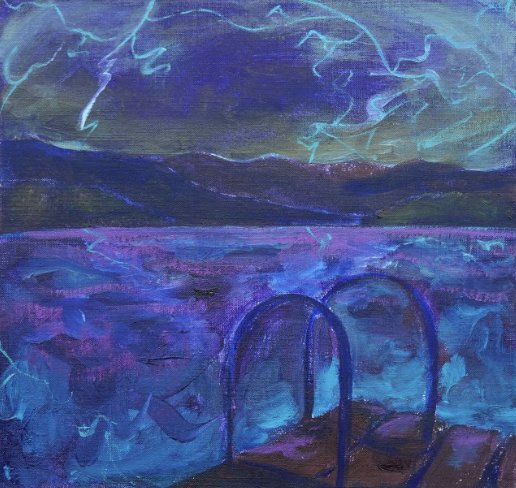“Glancing Light” painting by Colin Page
Watch a video of the live ZOOM reading of our fifth annual ekphrastic challenge, a collaboration between Page Gallery and The Poets Corner. NOTE: You can view the work online HERE, before viewing.
Ten poets, along with students read their work on The Poets Corner on Sunday, November 9.
Every year, the poets and the artists carefully deliberate over the submissions and curate a delightful mix of responses for the virtual and in-gallery readings.
Baby Lincoln and Stella Endicott | Chris Van Dusen
Baby, Take the Train | Lisa Merschel
With allusions to
Kate DiCamillo’s book
Where Are You Going, Baby Lincoln?
Fussy family members ban
them from holding maps,
from navigating on their own terms,
so off they go— two neighbors escape
hand-in-hand, on the lam.
Turn around, little Stella, unleash
adult Baby Lincoln’s hand.
Head home. Your captain-time
will come.
Listen, Baby: forget the past, the tasks, the
anxious breakfasts, the unmade bed.
Forget the lists, the what-to-dos and whys.
Board that train, and for goodness sake, read
the comics, devour jellybeans, the sour ones, handfuls
at a time.
Over your scratchy sweater, slip on
that silver-sequin dress you stole
from your sister’s closet. Don all your loot
from the Dollar Tree: the 13 miniature
Christmas wreath hair clips, L.A. Colors
hydrating lipstick in raging berry. Cool yourself
with the purple hand fan— starburst edition.
Apply the Better than Sex volumizing mascara—
pricier even than the high-density black wig.
Flip the thick hair, blink once—
notice the long lashes
licking your field of view. Flutter
your eyes and see the scene unfold
like the early movies—
in rapid-sequenced photographs.
Notice, finally, no need for disguise. No one
notices you. Notice that this is what travelers do. How people
mill about minding their own business, tending
to their interior gardens while you bloom in seat 3A.
Even so, just for once, assume the Marilyn Monroe:
lift your chin, squint, pucker, blow a kiss, your outstretched fingers
at right-angles with your lips. When the train rumbles to life,
leave Baby behind. Reclaim your name, Lucille. Hell, Lucy.
Then, pull off your dress, undecorate your wig,
unwig your hair, smudge your lipstick on tissue.
Sing a song to yourself, about a girl, in the sky
with diamonds.
But don’t budge that mascara. No, sister.
It will remind you, every few seconds, of a future
in pictures.
Tulips with Winter Painting | Susan Lichtman
Tulips in Winter | Charlotte Holmes
You’ve come to the end of landscape—
The nothing gleaned about desire
From a coral sky, from snow blue
As the long lost someone’s eyes
Never could have been. What old hurt
Insists that you remember how
The tulip’s dark heart unfolds just
Before the flower falls apart?
You look for meaning: arrangements
Of objects in space, cobalt and
Gold juxtaposed, the strange gray heart
At the center that signifies
Leaf, or shadow, or the open wound
The rest of the room coheres around.
Open Drawer | Susan Lichtman
Open Drawer | Brittany Deininger
Into the drawer went all of it—
fork and knife,
pack of batteries loose like beetles,
shame's tangle of snapped rubber bands,
what I didn’t say over the phone in decades
of blooming and broken branches,
what I sing only to myself and the dog,
two fruit flies carrying on in the kitchen
becoming legion,
the book of silences, cry of a girl-
child in my dream with no name.
What keeps opening the drawer a crack
in the night, just enough
to nick my hip, leave a mark?
Silver Glinting | Sal Taylor Kydd
Late Arrival | Sherry Abaldo
Out here there is an equilibrium.
For every pleasure craft, a working vessel.
For every summer house, the ghost of a
fish house. In World War II a Nazi
submarine penetrated Frenchman’s Bay,
dropped two would-be spies off in new snow.
Tonight I’m tired. Like old times I bring
you bread and apples. Like old times I am
transfixed by the view out the plane window:
form and void, bright and dark, a thousand
tastable touchable greys that glister like a
Cocteau film. Like the one where it ends up
a love story only the guy remains a beast.
In the morning all this moonglade will be blue.
Heat Lightning | Holden Willard
Accidental Prayer | Harriet Sandilands
E was the only person I knew who had a swimming pool, though it actually belonged to her
grandmother. It was fringed all around with raspberry bushes. Sometimes we would sneak into
the kitchen of her grandmother’s bungalow still dripping underneath our towels to make toast
lathered with butter, chocolate spread and sugar. We spent hours, days, whole summers in that
pool, designing synchronized swimming routines, staying in the water until we were wrinkled
like prunes. Once it thundered and lightninged and we remained in the water chanting Thunder!
Thunder! Come on Thunder! As though invoking some awesome God. Confused, I used to
scribble out prayers to that same God, asking him or her to take care of me and E and both our
families. The pool was deep, not embellished by fancy tiles. There may have been a diving
board. There may have been a small wooden shed for getting changed. The raspberry bushes,
prickled and dense, spoke profusely all through the summer. Hard to believe - now that
raspberries come in shallow plastic trays - just how much abundance we knew before. I wonder:
where were the adults as we swam and leapt through thunder and lightning? Were they away and
somewhere else like Louis MacNiece said of time? Four years later E’s sister was killed in a car
crash. A few years after that, her Dad had a heart attack at the top of the house where they had
installed some home gym equipment. Long out of touch, I now see pictures of E online; her
slimness always comes as a surprise. The skin around her once lovely plump thighs is loose,
though at certain angles she looks strangely lithe. I remember her dark hair and her soft body
thrashing out of the water in time with mine, her hand crammed full of raspberries, our secret
slices of toast spread with butter, chocolate and sugar. And I wonder, of everything that
happened, what was the prayer? Is it possible to pray something by accident? When we chanted
Thunder! Thunder! Come on thunder! What terrible chaos did we secretly summon? Whose
lightning was born from that heat?
Eclipse | Sonya Schneider
Oliver Watching the Eclipse | Sal Taylor Kydd
We don our special glasses
& wait for the shrouding
of the sun’s bright face.
We are the lucky ones
living in the dark inner
umbra. I come expecting
obscuration. Still, I’m hit
by surprise at the sudden
darkness & the chill
that climbs through my body.
Across the yard, trees transmit
light into hundreds of crescent
moons. Even my shadow
turns sharper. My son points
to the cloudless sky, his arm
covered in goosebumps.
Heads tilted upward,
we dwell briefly in totality.
Cottage Book: Deer in Woods | Breehan James
At the corn pile my brother-in-law leaves for the wildlife | Marianne Worthington
First light: the turkeys come. Maybe a dozen
hens carve their way through the woods flanked
by a lone tom who struts and makes a big deal
of his tail feathers. Then the bands of deer
who practice gender separation at feeding as strictly
as any Southern Baptist Sunday School Class.
The morning is chopped by the cardinals’ cries,
the crows telling it loud in the trees. Woodpeckers
hammer and watch for an open spot at the corn pile.
I watch it all from my sister’s kitchen window
while I wash up last night’s supper dishes, my desires
pooling in the tepid dishwater, greasy and gray,
no longer any count for scrubbing away these stains.
And Isn’t It Always There | Wendy Drexler
Cottage Book: Marble Light Room Curtain | Breehan James
in memory, or half-remembered—
was it once or maybe dozens of times—
a curtain drawn half-way back,
a wood-paneled wall with a print
of a low-slung sun or maybe a moon
like a ripe tomato, the water so white
the canoe is a grey ghost, and a table lamp,
the generosity of its pleated shade,
the Hunter-green base the shape
of an hourglass holding time at bay
in a motel room with my father
those inextinguishable Saturday nights
I spent with him because his new wife
didn’t want me at their house—oh, how
special I felt, just the two of us, a frosted
mug of root beer and a burger at the drive in,
before we’d check into the Dune Crest Motel,
or the Thunderbird on East Colfax.
I’d scoop matchbooks from a big glass
bowl on the front desk, then search our room
to see if anyone had left anything for me—
only a black bible in the nightstand drawer.
At bedtime, my father would swivel the cord
to snap the green drapes shut—their thick folds
almost too heavy for the rod to carry.
But now my father is telling me a story—
it’s the one about a stepdaughter
who is to become a princess.







